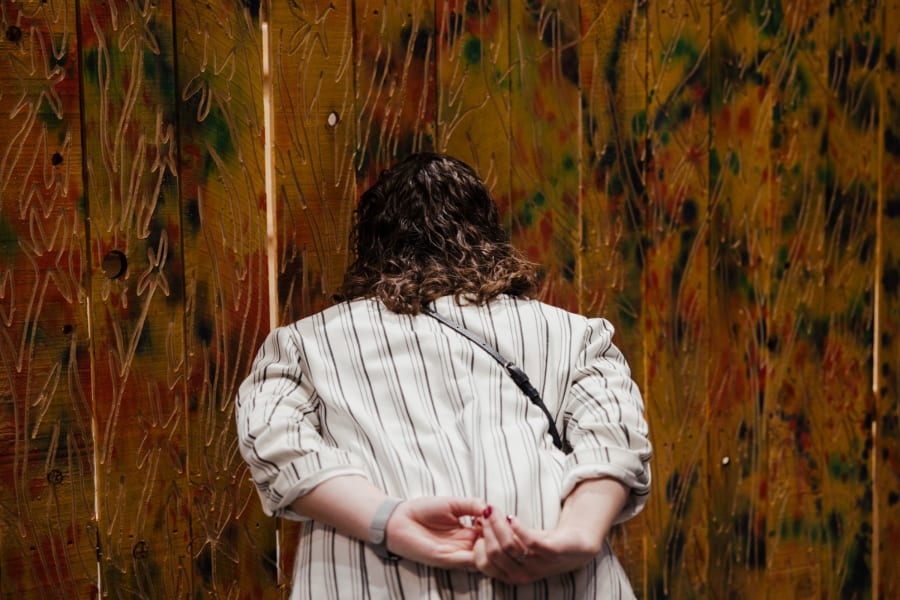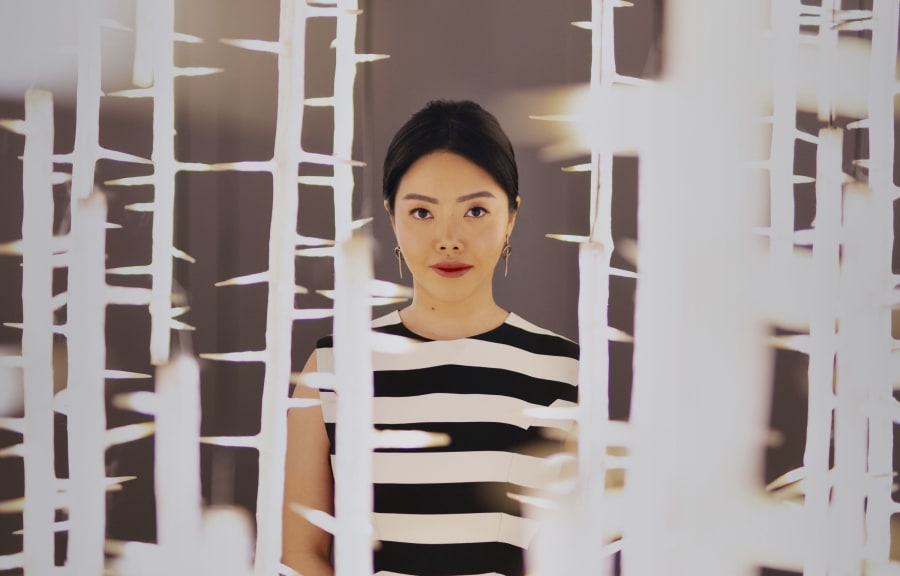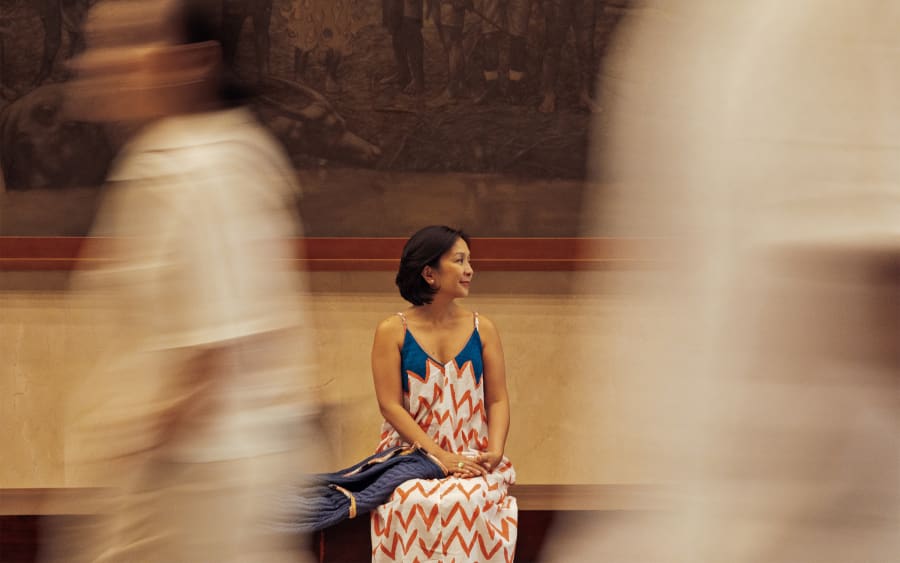Jun Tirtadji had just finished his studies in 2012 when he opened ROH, a contemporary art gallery in his hometown of Jakarta. With no previous background in the arts, his idea came from an intuitive sense of the creative potential in Indonesia. ‘The word “ROH” means spirit or soul,’ he says. ‘Instead of presenting our artists in a purely intellectual manner, we wanted to take a warmer, more sincere approach.’ His spontaneity and candor epitomize Jakarta’s burgeoning art scene. ‘What differentiates it from other places is its openness and inclusivity,’ says the gallerist. ‘It’s constantly evolving, dynamic, and curious.’
Historically one of Asia’s most important trading ports and with a population of almost 34 million, Jakarta is the world’s second-largest urban area. Despite its mammoth scale, the Indonesian capital has long suffered from a weak art infrastructure and an absence of state-funded institutions. For a long time, Yogyakarta and Bandung – charming university towns teeming with artists – overshadowed the megacity as more prominent cultural hotspots. Recently, however, Jakarta’s art scene has gained new momentum.
In the 1990s, the city was a cultural backwater with just a handful of informal art spaces, many lacking consistent programming. Today, however, contemporary galleries have popped up across the city. Previously located in an office tower, ROH recently moved into a colonial mid-century house in a residential neighborhood of Menteng, which has allowed for experimentation with larger-scale works. In 2022, the Jakarta- and Bandung-based collective Tromarama took over the new space with playful site-specific installations, including an inverted bouncy castle suspended from the ceiling (Patgulipat, 2022), a sound piece made using everyday objects (Beta, 2019), and a room wallpapered with blown-up images of fleshy thumbprints. The show, titled ‘Personalia’, explored the blurred boundaries between work and play in a digital era, and the idea of social-media users being 24-hour workers fueling the data economy.
In the same year, Singapore-headquartered Gajah Gallery also opened a sleek space in a residential complex in central Jakarta. ‘Indonesia has gone through almost 15 years of political stability. There’s a new crop of collectors here that want to get involved,’ says founder Jasdeep Sandhu. ‘We see the potential of Jakarta.’ Since the mid-1990s, when he began representing Indonesian artists such as Yunizar and Mangu Putra, Sandhu has been fascinated by the entire region. ‘The art history of Indonesia is exciting. So much of it is only now being realized and discovered. Not only contemporary artists but also the masters,’ he says, mentioning the late Balinese painter I Gusti Ayu Kadek Murniasih, whose Surrealist works explore violence and female sexuality. Sandhu also continues to run Yogya Art Lab – a foundry supporting the production of artwork of local artists in Yogyakarta – which he opened with Yunizar in 2012. ‘Yogyakarta is a tough place where artists struggle to survive. That inadvertently becomes fertile ground for artistic development,’ he says, adding that artists have a unique approach of banding together in groups. ‘It’s an informal system where they help each other in hard times. So, if somebody runs out of money, the community will help.’
Artist collectives and artist-led nonprofit organizations are the bedrock of the country’s thriving grassroots scene. While most collectives cluster in Yogyakarta, some are also active in the capital. In Jakarta, the collective Ruangrupa – who curated Documenta 15 – has joined forces with collectives Grafis Huru Hara and Serrum to open the public learning space Gudskul. Located on the outskirts of South Jakarta, the Gudskul Ekosistem – several small structures including converted shipping containers – hosts artists and educators who run workshops and educational programs. Here, artists, writers, curators, musicians, and film directors gather to exchange ideas on how to sustain their own practices and the country’s art ecosystem. At the heart of the Gudskul Ekosistem is the idea of nongkrong (‘hanging out’), which allows for organic knowledge-sharing and collaboration.
‘There are a lot of community-driven efforts here. That is precious in the art world, where people can sometimes have big egos and prefer to work alone,’ says Venus Lau, who was struck by the convivial nature of the city’s art scene when she moved to Jakarta last year to helm Museum MACAN. ‘Indonesia is a treasure [trove] of histories and cultures in different forms. It’s not only about high-end culture, but [creativity] is visible in the food, music, and film, which are accessible to a lot of people.’
One of MACAN’s primary goals has been to give the broader public access to contemporary art, which is important given the absence of public institutions. (Jakarta’s only state-funded museum is the National Gallery of Indonesia, which has limited programming.) Since Indonesian philanthropist Haryanto Adikoesoemo founded the private institution in 2017, MACAN has become a linchpin in the city’s art ecosystem, offering a much-need platform for Indonesian artists.
‘We are showing work that people don’t expect to see,’ says Lau of MACAN’s ambitious programming. She is particularly proud of the museum’s commitment to women artists from the region, citing the recent solo exhibition of Melati Suryodarmo – known for her physically-challenging durational performances – as an example. For the show, Suryodarmo performed works such as I’m a ghost in my own house (2012), grinding hundreds of kilograms of charcoal into dust with a rolling pin over the course of 12 hours. The grueling work, which left her disheveled and smeared in soot, was a meditation on the notion of ‘home’, the loss of potential and the beauty of life. The museum also spotlights emerging artists like Natasha Tontey. Her current exhibition, ‘Primate Visions: Macaque Macabre,’ commissioned by Audemars Piguet Contemporary, playfully explores the Minahasan people’s relationship with black-crested macaques. Harnessing speculative fiction and indigenous cosmology, Tontey created a DIY-style video installation that interrogates anthropocentrism.
Other private institutions in Jakarta include Indonesian businessman Rudy Akili’s eponymous Akili Museum of Art and the Ciputra Museum, founded by real-estate developer Ir. Ciputra, which has a large holding of works by Indonesian artist Hendra Gunawan. Alongside private patrons and gallerists who have been instrumental in kick-starting the capital’s art scene, the Art Jakarta contemporary fair, now running for more than a decade, has developed a strong identity. The Jakarta Biennale – which, founded in 1974, is the oldest event of its kind in Southeast Asia – has also come into its own and is revered for its community-centric approach. The 2024 edition, for instance, was organized by various art collectives. Free from a theme or an official team of curators, the Jakarta Biennale embodies the open-mindedness and experimental nature of the city’s art scene.
Looking beyond Jakarta, it’s intriguing to note that Indonesian artists have increasingly been attracting more international attention in recent years. One example is Bandung-based Bagus Pandega, whose practice explores new ways of engaging with technology and ecology. Pandega’s first institutional solo show in Europe, exploring the impact of nickel mining on the Indonesian island of Halmahera, will be on view at Kunsthalle Basel this summer. A show at the Swiss Institute in New York will follow. This year, Bandung – a long-established nerve center in Indonesia’s art scene – will celebrate the 70th anniversary of the 1955 Bandung Conference, in which 29 newly independent states in Africa and Asia met in the city to establish and promote African-Asian cooperation and oppose colonialism.
Pandega is among many talented graduates of the Bandung Institute of Technology. Another artist based in the city, Kei Imazu (Pandega’s partner), is also making waves overseas. Born in Japan, Imazu opened a solo exhibition this month at Tokyo Opera City Art Gallery, showing paintings and installations inspired by the mythological Indonesian goddess Hainuwele. The goddess was born from a coconut tree on Seram Island and later murdered by suspicious villagers. Her body parts were scattered around the land, where essential crops began to grow, providing food to the community. Imazu was fascinated to find parallels between Hainuwele’s story and that of the Japanese fertility goddess Jomon Venus.
With its trio of vibrant art hubs, the Indonesian archipelago continues to provide fertile ground for artistic production. No longer just a transit stop for those heading to Bandung or Yogyakarta, Jakarta has evolved into a dynamic art destination in its own right.
Payal Uttam is an independent writer and editor who divides her time between Hong Kong and Singapore. She contributes to a range of publications, including Artsy, The Art Newspaper, South China Morning Post, and The Wall Street Journal.
Top image: a visitor at MACAN. Photography by Farid Renais Ghimas for Art Basel.
Published on January 15, 2025.


